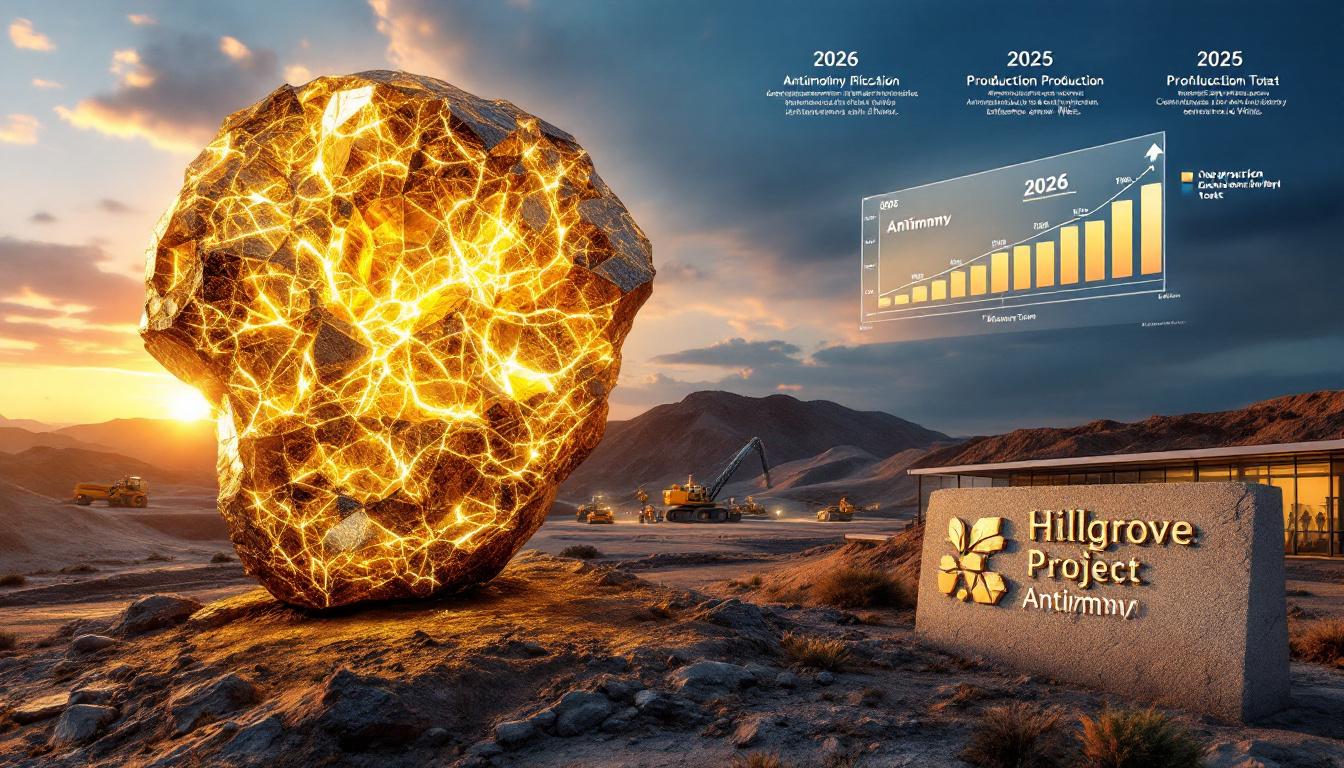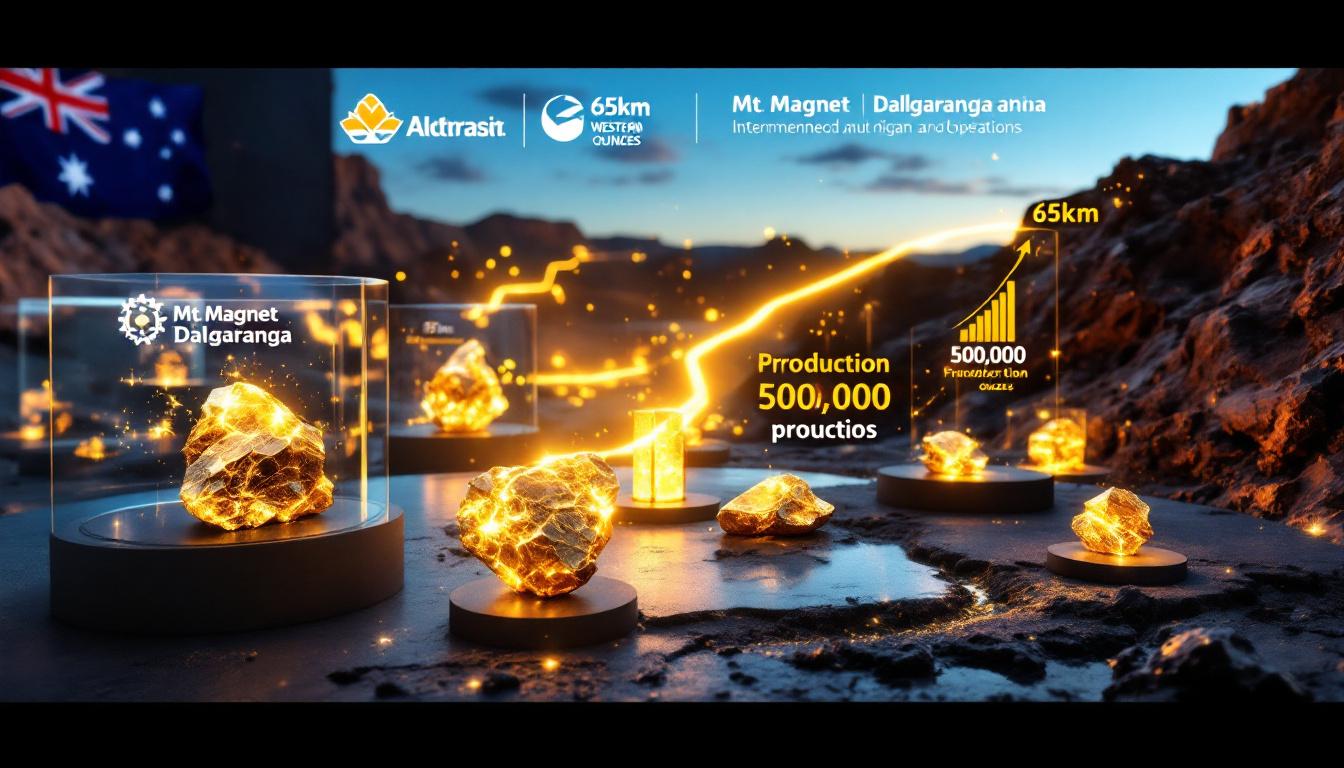The Gold Rush Continues: Understanding the Wave of Mining Sector Consolidation
The gold mining industry is experiencing a significant wave of consolidation in 2025, fueled by record high gold prices and companies flush with cash. This trend reflects a strategic shift in how major producers are approaching growth, with a renewed focus on disciplined acquisitions and shareholder returns. The current gold sector consolidation and acquisitions are reshaping the landscape of the precious metals industry, creating larger entities with expanded production profiles and development pipelines.
What's Driving the Current Gold Sector Consolidation Trend?
Record Gold Prices Fueling Cash Reserves
The unprecedented surge in record high gold prices has dramatically strengthened the financial position of major mining companies, creating substantial cash reserves that are driving acquisition strategies. Gold producers are generating record quarterly free cash flow, with industry leader Newmont Corporation reporting an impressive US$1.7 billion in Q2 2025 alone.
This financial strength has positioned companies to pursue strategic growth while simultaneously returning capital to shareholders. With enhanced liquidity, producers can act decisively when acquisition opportunities arise, particularly for assets that complement existing operations.
The improved balance sheets across the sector represent a marked contrast to previous cycles, when many companies were burdened by debt from earlier expansion efforts. Today's gold producers are leveraging their financial flexibility to pursue value-accretive transactions while maintaining fiscal discipline.
Strategic Resource Expansion Through Acquisitions
A key driver behind the current consolidation wave is the strategic imperative to expand resource bases and secure future production. Companies are specifically targeting projects with geographic proximity to existing operations, allowing them to leverage established infrastructure and operational expertise.
The focus has shifted noticeably toward advanced exploration assets that can be developed within a relatively short timeframe. Projects with potential to enter production within 24-36 months are particularly coveted, as they provide near-term growth without the extended development horizons typically associated with greenfield discoveries.
Regional consolidation has emerged as a dominant strategy, with companies acquiring neighboring properties to create operational hubs. This approach maximizes synergies by centralizing processing facilities, optimizing logistics networks, and sharing management resources across multiple assets.
Premium Valuations in Recent Transactions
The competitive landscape for quality gold assets has resulted in significant acquisition premiums, typically ranging from 18-35% above target companies' trading prices. These premiums reflect both the strategic value of the assets and the robust financial position of the acquirers.
Most transactions in the current cycle are structured primarily as share-based deals rather than cash offers. This approach preserves liquidity while giving target shareholders continued exposure to the combined entity's growth potential.
Premium calculations generally reference the 30-day volume-weighted average price (VWAP) of the target company, providing a more stable valuation metric than spot prices. Assets with exceptional characteristics—high grades, expansion potential, or location in tier-one jurisdictions—have commanded premiums at the upper end of the range, sometimes exceeding 40% in particularly competitive situations.
What Are the Most Significant Recent Gold Sector Deals?
Major North American Transactions
The North American gold sector has been particularly active in 2025, with several transformative transactions reshaping the competitive landscape. In July 2025, Torex Gold Resources acquired Prime Mining for C$449 million, representing a 32.4% premium to Prime's 30-day VWAP. This strategic move consolidated Mexican gold assets, incorporating the promising Los Reyes project with its 2.38 million ounces of gold and 75.6 million ounces of silver into Torex's portfolio. The combined entity is positioned to produce over 450,000 ounces annually, creating a mid-tier producer with significant growth potential.
In another notable transaction, McEwen Mining announced its pursuit of Canadian Gold Corp in July 2025, offering a 26% premium to Canadian Gold's 30-day VWAP. The primary target is the Tartan mine in Manitoba, which presents restart potential and fits strategically with McEwen's existing Fox Complex operations. This acquisition exemplifies the trend of companies seeking brownfield assets with established infrastructure that can be brought back into production efficiently.
AngloGold Ashanti has also been expanding its footprint in Nevada, completing a C$152 million acquisition of Augusta Gold Corp in July 2025. This transaction represents strategic positioning in a key North American mining jurisdiction, enhancing AngloGold's development pipeline in an established gold district with favorable operating conditions and significant exploration upside.
Australian Market Consolidation
The Australian gold sector has witnessed parallel consolidation activity, with Capricorn Metals' A$188 million acquisition of Warriedar Resources in July 2025 standing out as particularly significant. The deal came with a substantial 35% premium to Warriedar's 30-day VWAP, reflecting the strategic value of the Golden Range project, which contains 1.38 million ounces of gold and 60,000 tonnes of antimony.
The geographic synergy with Capricorn's Mt Gibson project, located just 90 kilometers away, presents obvious operational advantages. This acquisition is expected to enhance Capricorn's second gold operation, which is projected to produce approximately 150,000 ounces annually once fully operational.
Australian consolidation has been characterized by a focus on regional hubs, with companies seeking to maximize the utilization of processing infrastructure through satellite deposits. This approach optimizes capital efficiency while extending the productive life of existing operations.
Silver Sector Parallel Activity
While gold has dominated headlines, the silver mining space has experienced its own consolidation trend throughout 2025. Torex Gold's US$26 million acquisition of Reyna Silver Corp in June 2025 exemplifies the growing trend of gold producers diversifying into silver assets.
This diversification strategy reflects recognition of silver's dual role as both a precious and industrial metal, particularly with growing demand from renewable energy technologies and electronics manufacturing. Companies with existing precious metals expertise see silver acquisitions as a natural extension of their core competencies while providing portfolio diversification.
How Are Gold Companies Managing Their Increasing Cash Reserves?
Share Buyback Programs Gaining Momentum
A notable trend among major gold producers has been the implementation of significant share buyback programs to return capital to shareholders. Newmont Corporation announced an additional US$3 billion share buyback in July 2025, having already repurchased US$1.35 billion in shares earlier in 2025 (following US$1.24 billion in 2024).
Australian producer Northern Star Resources completed an A$300 million buyback in the June quarter of 2025, repurchasing 27.2 million shares at an average price of A$11.04. This program represents a significant portion of the company's market capitalization and demonstrates management's confidence in the underlying value of their assets.
OceanaGold has also embraced this approach, renewing its program to repurchase up to 23 million shares (representing approximately 10% of its public float). The company has already repurchased US$65 million in shares over the previous 12 months, highlighting a sustained commitment to this capital return mechanism.
Strategic Rationale for Buybacks
The strategic rationale behind these buyback programs is multifaceted. Many management teams view their company shares as significantly undervalued relative to the underlying assets, particularly when measured against the current gold price environment. By reducing the number of outstanding shares, buybacks improve per-share metrics for remaining shareholders, enhancing earnings per share, cash flow per share, and reserves per share.
Buybacks also offer tax efficiency compared to other capital return mechanisms like dividends, as shareholders can defer tax implications until they choose to sell their holdings. This approach provides management teams with flexibility to capitalize on market volatility, opportunistically repurchasing shares during periods of weakness.
Perhaps most importantly, substantial buyback programs signal management confidence in the company's outlook, suggesting that leadership teams believe their internal growth prospects offer superior returns to alternative investment opportunities.
Balancing Capital Allocation Priorities
Gold producers are maintaining a delicate balance in their capital allocation strategies, focusing on sustainable production rather than pursuing aggressive growth targets that characterized previous cycles. This disciplined approach reflects lessons learned from past mistakes, when overambitious expansion plans ultimately destroyed shareholder value.
Companies are prioritizing organic project development alongside selective acquisitions, ensuring that capital is deployed efficiently to maximize returns. Many producers have articulated clear frameworks for capital allocation, with defined thresholds for investment returns and rigorous evaluation processes for potential opportunities.
This balanced approach allows companies to maintain operational flexibility while fulfilling commitments to shareholder returns. By establishing clear priorities and communicating them effectively to investors, management teams are building credibility and demonstrating their alignment with shareholder interests.
What Lessons Have Been Learned From Previous Consolidation Cycles?
Historical Context of Gold Sector M&A
The gold mining industry carries the scars of previous consolidation cycles, with North American large-cap producers having written off an estimated US$45 billion between 2011 and 2015. This sobering statistic reflects a period characterized by a growth-at-any-cost mentality, when companies paid significant premiums for assets that ultimately failed to deliver projected returns.
The previous cycle was marked by aggressive expansion initiatives, often driven more by a desire to increase production scale than by disciplined financial analysis. Major development projects frequently experienced substantial capital expenditure overruns, eroding returns and damaging shareholder value.
These historical missteps created a generation of investors wary of growth initiatives, particularly those financed through debt or excessive share issuance. The industry's collective memory of these challenges continues to influence current decision-making processes.
Current Management Approach
Today's gold sector executives exhibit heightened wariness about repeating the mistakes of previous cycles. Management teams are emphasizing disciplined capital allocation, with a clear focus on sustainable production rather than headline growth figures.
There is a marked preference for projects with a clear path to profitability, supported by robust feasibility studies and conservative price assumptions. Companies are conducting more thorough due diligence on potential acquisitions, with particular attention to operating costs, capital requirements, and execution risks.
The emphasis has shifted decisively toward returns-focused investment criteria, with internal rate of return (IRR) thresholds typically set at 15-20% for new projects. This disciplined approach extends to acquisition strategies, with companies seeking transactions that are immediately accretive to cash flow and earnings.
Industry Expert Perspectives
Canaccord Genuity analyst Carey MacRury has highlighted investors' intense focus on cashflow deployment, noting that "the market is rewarding companies that demonstrate capital discipline and clear pathways to shareholder returns." This perspective captures the prevailing sentiment among institutional investors, who are carefully monitoring how companies utilize their strengthened cash positions.
Industry experts anticipate continued M&A activity in specific segments of the gold sector. Producer consolidation is expected to accelerate as companies seek operational scale to reduce costs and enhance market relevance. Royalty company transactions are likely to increase as these entities look to diversify revenue streams across multiple projects and jurisdictions. Developer acquisitions will remain attractive as major producers seek to secure future production pipelines amid declining reserve replacement rates.
"The companies that will outperform in this cycle are those that maintain discipline while strategically positioning themselves for sustainable growth. We're seeing a much more measured approach to M&A than in previous cycles, with transactions that complement existing operations rather than transformative deals that introduce new complexities." — Carey MacRury, Canaccord Genuity
How Are Major Gold Producers Approaching Future Growth?
Organic Project Development
While acquisitions capture headlines, many major gold producers are prioritizing organic project development to drive future growth. Northern Star Resources exemplifies this approach, focusing on internal opportunities including a A$1.5 billion expansion of the KCGM mill and development of the newly acquired Hemi project.
This emphasis on extracting maximum value from existing asset portfolios reflects a strategic shift in the industry. Companies are increasingly recognizing that brownfield expansions and operational improvements at current mines often offer superior returns compared to new acquisitions, with lower execution risk and capital requirements.
Technical innovations in mining methods, processing technologies, and automation are enabling companies to optimize existing operations and extract value from previously marginal resources. These initiatives frequently deliver meaningful production growth and cost reductions without the integration challenges associated with acquisitions.
Management Commentary on Strategy
Industry leaders have been explicit about their strategic priorities in recent communications. Newmont CEO Tom Palmer stated during the company's Q2 earnings call: "Our focus is internal, and the best use of our capital is to buy back Newmont stock. We see tremendous value in our own shares relative to our asset base."
Northern Star Managing Director Stuart Tonkin has similarly emphasized the value of organic growth, noting that "returns out of these organic investments are significant, and they leverage our existing infrastructure and operational expertise in ways that would be difficult to replicate through acquisitions."
These statements reflect an industry-wide shift toward disciplined growth and shareholder returns, with a clear recognition that sustainable value creation requires patience and operational excellence rather than aggressive expansion.
Balance Between Acquisitions and Internal Projects
The most successful companies are maintaining a balance between selective acquisitions and internal project development. The ideal acquisition targets complement existing operations, allowing companies to leverage established infrastructure and operational expertise. There is a clear preference for assets in established mining jurisdictions with predictable regulatory frameworks and skilled workforces.
Companies are focusing on transactions that are immediately accretive to key financial metrics, avoiding deals that might dilute short-term performance even if they offer long-term strategic benefits. This approach reflects the market's limited patience for gold sector consolidation deals that defer returns to distant future periods.
By maintaining this balance, gold producers can pursue sustainable growth while continuing to deliver competitive shareholder returns. This measured approach represents a significant evolution from previous cycles, when growth often came at the expense of near-term financial performance.
What Should Investors Watch During Gold Sector Reporting Season?
Key Financial Metrics to Monitor
As gold companies report their financial results, investors should closely monitor free cash flow generation amid record high gold prices. This metric provides the clearest indication of a company's ability to fund growth initiatives while returning capital to shareholders.
All-in sustaining cost (AISC) trends deserve particular attention in the current inflationary environment. Companies that can maintain cost discipline while prices rise will generate superior margins and demonstrate operational excellence.
Capital allocation priorities and project development timelines offer insights into management's strategic vision and execution capabilities. Companies should articulate clear frameworks for deploying capital, with specific return thresholds and evaluation criteria.
Balance sheet strength and net cash positions provide foundations for future growth and shareholder returns. The transition from net debt to net cash positions for many producers represents a fundamental strengthening of the sector's financial health.
Capital Management Announcements
The upcoming reporting season may bring additional share buyback program announcements as companies deploy their strengthened cash positions. Investors should evaluate the scale of these programs relative to market capitalization and free cash flow generation.
Dividend policy updates and special distribution possibilities will be closely watched, with potential for increased base dividends or one-time payments linked to gold price performance. Companies with progressive dividend policies that increase distributions systematically over time typically attract premium valuations.
Project funding commitments for major developments will signal confidence in internal growth opportunities. The scale and timing of these investments provide insights into companies' production growth trajectories and capital intensity.
Management teams will likely articulate their M&A strategies, identifying target criteria and potential geographic focus areas. These statements should be evaluated against the company's historical execution and integration capabilities.
Production Outlook and Cost Guidance
The impact of higher gold prices on reserve calculations and mine life extensions will be a critical focus area. Higher price assumptions in reserve models can significantly expand economically recoverable resources, potentially extending mine lives and enhancing asset values.
Production growth projections for 2025-2026 will reveal which companies are positioned to capitalize on the favorable price environment. Investors should distinguish between sustainable production increases driven by operational improvements and temporary gains from higher-grading strategies.
Cost inflation management strategies will differentiate superior operators from their peers. Companies with effective procurement processes, energy management programs, and labor productivity initiatives will be better positioned to maintain margins despite inflationary pressures.
Operational efficiency initiatives, including automation, digitalization, and process optimization, can deliver sustainable cost advantages. These programs often require upfront investment but generate lasting benefits through reduced labor requirements, improved equipment utilization, and enhanced recovery rates.
FAQ: Gold Sector Consolidation Trends
Why are gold companies focusing on share buybacks instead of dividends?
Share buybacks offer several advantages in the current market environment. They provide tax efficiency, as shareholders don't incur immediate tax liabilities unlike dividend payments. Buybacks improve per-share metrics by reducing the number of outstanding shares, enhancing earnings per share, cash flow per share, and reserves per share.
They also demonstrate management confidence in the company's outlook, suggesting that leadership teams believe their shares represent superior value compared to alternative investments. Buybacks provide flexibility to capitalize on market volatility, allowing companies to repurchase shares opportunistically during periods of weakness.
For companies that believe their shares are undervalued relative to their asset base, buybacks represent an efficient allocation of capital that can deliver significant long-term returns to continuing shareholders.
What types of gold assets are most attractive for acquisition?
Companies are primarily targeting advanced exploration or development-stage projects with clear paths to production, preferably located near existing operations to leverage infrastructure synergies. Assets with production potential within 24-36 months are particularly sought after, as they provide visible growth without extended development timelines.
Projects in established mining jurisdictions with predictable regulatory frameworks and available skilled workforces command premium valuations. High-grade deposits are especially attractive in the current inflationary environment, as they typically offer greater margin protection against rising costs.
Assets with expansion potential beyond initial development plans provide optionality value that sophisticated acquirers recognize and incorporate into their valuation models. This potential for future growth can justify higher acquisition premiums compared to projects with limited expansion prospects.
How are acquisition premiums determined in gold sector deals?
Premiums typically range from 18-35% above target company trading prices, usually calculated based on 30-day volume-weighted average prices
Want to Discover the Next Major Mining Opportunity?
Stay ahead of the market with Discovery Alert's proprietary Discovery IQ model, delivering instant notifications on significant ASX mineral discoveries as they happen. Explore why major discoveries can lead to exceptional returns by visiting our dedicated discoveries page and start your 30-day free trial today.




